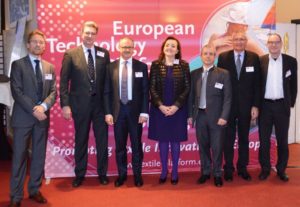 Over 150 participants from 20 countries at the European Technology Platform for the Future of Textiles and Clothing witnessed a very broad overview of key textile technologies which moved from research labs into industrial practice over the last 10 years or which are expected to do so over the next 10 years. The event was an impressive demonstration of how innovative, high-tech and diversified the EU textile and clothing sector has become.
Over 150 participants from 20 countries at the European Technology Platform for the Future of Textiles and Clothing witnessed a very broad overview of key textile technologies which moved from research labs into industrial practice over the last 10 years or which are expected to do so over the next 10 years. The event was an impressive demonstration of how innovative, high-tech and diversified the EU textile and clothing sector has become.
Alluding to these developments in his opening address, Paolo Canonico, President of the Technology Platform, stated «Few people would have predicted this incredible transformation of our sector back in 2004, the year when the Textile ETP was launched and incidentally also the year when the last textile import quotas were phased out. While it is true that we lost many companies and industry jobs in the following 5-year period, the companies that have successfully navigated this phase are more competitive and resilient than before. While holding on to the majority of its turnover, the industry has increased its productivity by almost 50% and extra-EU exports have risen by one third to over €42 billion during the last 10 years».
Concluding his remarks Paolo Canonico expressed his conviction that the high-tech transformation of the sector would gather further steam in the coming decade making the need for collaboration with the academic and applied research sectors more important and further reinforcing the role of the Technology Platform as an enabler of European networking, knowledge transfer and access to funding.
Clara de la Torre, director for Key Enabling Technologies in the Directorate-General for Research & Innovation, European Commission, highlighted the successful participation of the textile and clothing sector in EU programmes in the past 10 years. She also stressed the crucial role that the Technology Platform has played in facilitating access to these funding opportunities especially for SME’s as well as enabling collaboration with other sectors.
Academic and applied textile research institutions had a key role in ensuring that the technologies for industrial breakthroughs for the next 10 years are explored, developed and successfully transferred to industry. Jean-François Aguinaga, head of the textiles and fashion industry unit of the European Commission’s newly created DG GROW, reminded participants of the overriding policy goal of the EC under President Juncker of creating economic growth and jobs, the related € 315 billion investment package and various initiatives that will involve individual sectors such as textiles and clothing into the practical implementation. EURATEX President Serge Piolat as well as speakers for the French and Italian textile and fashion industries outlined the future strategies of the federations and remarkably all finished on a high note regarding the current business prospects showing positive sales trends based on a recovering internal market and an even stronger contribution from exports.




